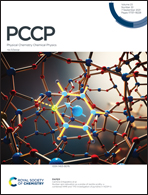Electron attachment to microhydrated 4-nitro- and 4-bromo-thiophenol†
Abstract
We investigate the effect of microhydration on electron attachment to thiophenols with halogen (Br) and nitro (NO2) functional groups in the para position. We focus on the formation of anions upon the attachment of low-energy electrons with energies below 8 eV to heterogeneous clusters of the thiophenols with water. For nitro-thiophenol (NTP), the primary reaction channel observed is the associative electron attachment, irrespective of the microhydration. On the other hand, bromothiophenol (BTP) fragments significantly upon the electron attachment, producing Br− and (BTP–H)− anions. Microhydration suppresses fragmentation of both molecules, however in bromothiophenol, the Br− channel remains intense and Br(H2O)n− hydrated fragment clusters are observed. The results are supported by the reaction energetics obtained from ab initio calculations. Different dissociation dynamics of NTP and BTP can be related to different products of their plasmon induced reactions on Au nanoparticles. Computational modeling of the simplified BTP(H2O) system indicates that the electron attachment products reflect the structure of neutral precursor clusters – the anion dissociation dynamics is controlled by the hydration site.



 Please wait while we load your content...
Please wait while we load your content...